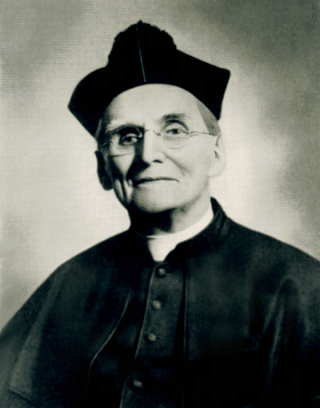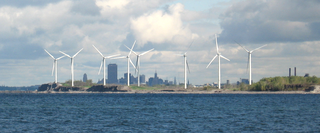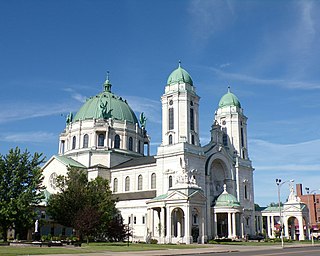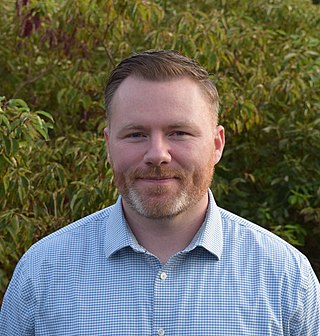
Hornell is a city in Steuben County, New York, United States. The population was 8,259 at the 2020 census. The city is named after the Hornell family, early settlers.

Scranton is a city in and the county seat of Lackawanna County, Pennsylvania, United States. With a population of 76,328 as of the 2020 U.S. census, Scranton is the most populous city in Northeastern Pennsylvania and the Wyoming Valley metropolitan area, which has a population of 562,037 as of 2020. It is the sixth-most populous city in Pennsylvania.

The Bethlehem Steel Corporation was an American steelmaking company headquartered in Bethlehem, Pennsylvania. Until its closure in 2003, it was one of the world's largest steel-producing and shipbuilding companies. At the height of its success and productivity, the company was a symbol of American manufacturing leadership in the world, and its decline and ultimate liquidation in the late 20th century is similarly cited as an example of America's diminished manufacturing leadership. From its founding in 1857 through its 2003 dissolution, Bethlehem Steel's headquarters were based in Bethlehem, Pennsylvania, in the Lehigh Valley region of the United States. Its primary steel mill manufacturing facilities were first located in Bethlehem, Pennsylvania and later expanded to include a major research laboratory in Bethlehem, Pennsylvania, and plants in Sparrows Point, Maryland, Johnstown, Pennsylvania, Lackawanna, New York, and its final and largest site in Burns Harbor, Indiana.

Salamanca is a city in Cattaraugus County, New York, United States, inside the Allegany Indian Reservation, one of two governed by the Seneca Nation of New York. The population was 5,929 at the 2020 census. It was named after José de Salamanca, a Spanish nobleman and cabinet minister of the mid-19th century. Salamanca invested in railroads around the globe, including the Atlantic and Great Western Railroad in New York State, Pennsylvania, and Ohio.

Cheektowaga is a town in Erie County, New York, United States. As of the 2020 census, the town has grown to a population of 89,877. The town is in the north-central part of the county, and is an inner ring suburb of Buffalo. The town is the second-largest suburb of Buffalo, after the Town of Amherst.

West Seneca is a town in Erie County, New York, United States. The population was 45,500 at the 2020 census. West Seneca is a centrally located interior town of the county, and a suburb of Buffalo. West Seneca, Orchard Park and Hamburg form the inner "Southtowns", a cluster of middle-class suburban towns.

The Lackawanna Six is a group of six Yemeni-American friends who pled guilty to charges of providing material support to al-Qaeda in December 2003, based on their having attended an al-Qaeda training camp in Afghanistan together in the Spring of 2001. The suspects were facing likely convictions with steeper sentences under the "material support law".

New York State Route 5 (NY 5) is a state highway that extends for 370.80 miles (596.74 km) across the state of New York in the United States. It begins at the Pennsylvania state line in the Chautauqua County town of Ripley and passes through Buffalo, Syracuse, Utica, Schenectady, and several other smaller cities and communities on its way to downtown Albany in Albany County, where it terminates at U.S. Route 9 (US 9), here routed along the service roads for Interstate 787 (I-787). Prior to the construction of the New York State Thruway, it was one of two main east–west highways traversing upstate New York, the other being US 20. West of New York, the road continues as Pennsylvania Route 5 (PA 5) to Erie.

Western New York (WNY) is the westernmost region of the U.S. state of New York. The eastern boundary of the region is not consistently defined by state agencies or those who call themselves "Western New Yorkers". Almost all sources agree WNY includes the cities of Buffalo, Niagara Falls, Jamestown, and the surrounding suburbs, as well as the outlying rural areas of the Great Lakes lowlands and Niagara Frontier, and Chautauqua-Alleghany. Many would also place Rochester and the Genesee Valley in the region, while some would also include the western Finger Lakes within the region. Others would describe the latter three areas as being in a separate Finger Lakes region.

Nelson Henry Baker was a Catholic priest and church administrator in the Buffalo, New York, area. At the time of his death in 1936, he had developed a "city of charity" at Our Lady of Victory Basilica in Lackawanna, New York. It consisted of a minor basilica, an infant home, a home for unwed mothers, a boys' orphanage, a boys' protectory, a hospital, a nurses' house, and a grade and high school.

South Buffalo is a neighborhood that makes up the southern third of the City of Buffalo, New York. Traditionally known for its large Irish-American community, this community also has a strong presence of various other nationalities. The once-heavily industrialized district was home to many steel mills, automotive parts manufacturers, petroleum refineries, foundries, and machine shops. However, due to increasing deindustrialization and rising unemployment, the area has experienced growing problems with poverty and population decline.

Steel Winds is a wind energy project located on the coast of Lake Erie in Lackawanna, New York, just south of the City of Buffalo in Erie County. Its first phase was operational in 2007 and the second phase came online in 2012, for a combined production capacity of 35 MW. The unique project was built on part of the brownfield of a former Bethlehem Steel plant. By using much of the existing infrastructure of roads and transmission lines, it could reduce project costs. It is one of the largest urban wind farms in the world and uses turbines manufactured in Iowa.
The Lackawanna Steel Company was an American steel manufacturing company that existed as an independent company from 1840 to 1922, and as a subsidiary of the Bethlehem Steel company from 1922 to 1983. Founded by the Scranton family, it was once the second-largest steel company in the world. Scranton, Pennsylvania, developed around the company's original location. When the company moved to a suburb of Buffalo, New York, in 1902, it stimulated the founding of the city of Lackawanna.

The 2008 U.S. embassy attack in Yemen in Sana'a, Yemen on September 17, 2008, resulted in 18 deaths and 16 injuries. Six attackers, six Yemeni police and six civilians were killed. This attack was the second occurring in the same year, after a mortar attack earlier in 2008 on March 18 missed the embassy and instead hit a nearby girls' school. Islamic Jihad of Yemen, an al Qaeda affiliate, claimed responsibility for the attack.

The Our Lady of Victory Basilica is a Catholic parish church and national shrine in Lackawanna, New York. Due to the multiple charities of founder Father Nelson Baker, the shrine is a popular pilgrimage and visitor destination in Lackawanna. It is part of the Diocese of Buffalo.

Salamanca was a railroad station for the Erie Railroad in Salamanca, New York, United States. The station was located at 137 Main Street in Salamanca, across the track from the Buffalo, Rochester and Pittsburgh Railway depot. Located as the terminus of the Meadville Division of the Erie Railroad main line, Salamanca was considered part of the Allegany Division, which went between Dunkirk and Hornell.

Catholic Health is a non-profit comprehensive healthcare system formed in 1998 under religious sponsors in Western New York, United States. The organization provides health services through their hospitals, primary care centers, diagnostic and treatment centers, home care agencies, long-term care facilities and other programs. The system brings together more than 9,000 associates and 1,300 physicians to the Western New York market. Its Sisters of Charity Hospital in Buffalo, New York is a clinical affiliate of the New York Institute of Technology College of Osteopathic Medicine, one of the largest medical schools in the United States.

On November 9, 2016, around 7:30 a.m., a major fire broke out at a 1-million-square-foot (93,000 m2) galvanizing warehouse that was formerly part of the now-vacated Bethlehem Steel complex in Lackawanna, New York, just south of Buffalo. The fire was said to have been caused by a hot bulb which fell and struck cardboard inside of the building, igniting the structure, although this has not been confirmed. Subsequently, a thick ash cloud extended 30 mi (48 km) south of the accident site, viewable from Canada, Eden, New York, and weather radars. Hundreds of firefighters from area departments, including the Buffalo Fire Department, assisted in rescue operations, which resulted in one injury.

Patrick B. Burke is an American politician who serves in the New York State Assembly from the 142nd district, which represents South Buffalo, the City of Lackawanna, and the towns of West Seneca and Orchard Park. Burke is a South Buffalo native.
Abdulsalam K. Noman is a Yemeni-American politician and soccer coach. He is the first Yemeni-American elected to public office in the state of New York, and the second in the United States




























